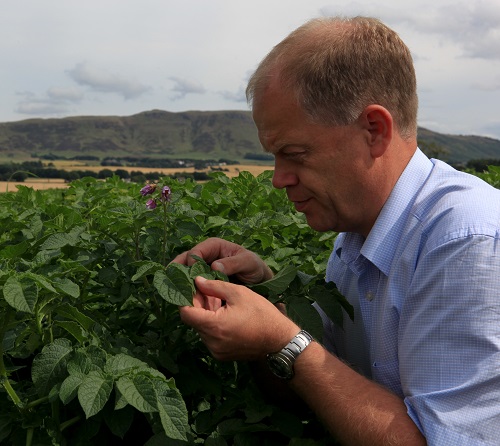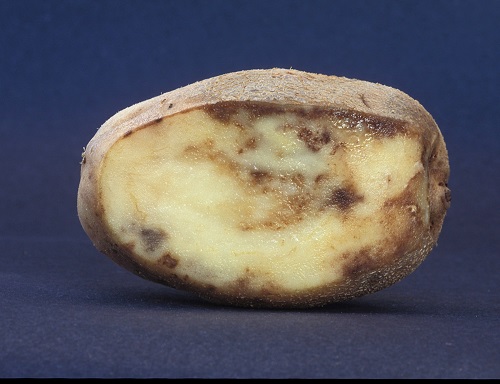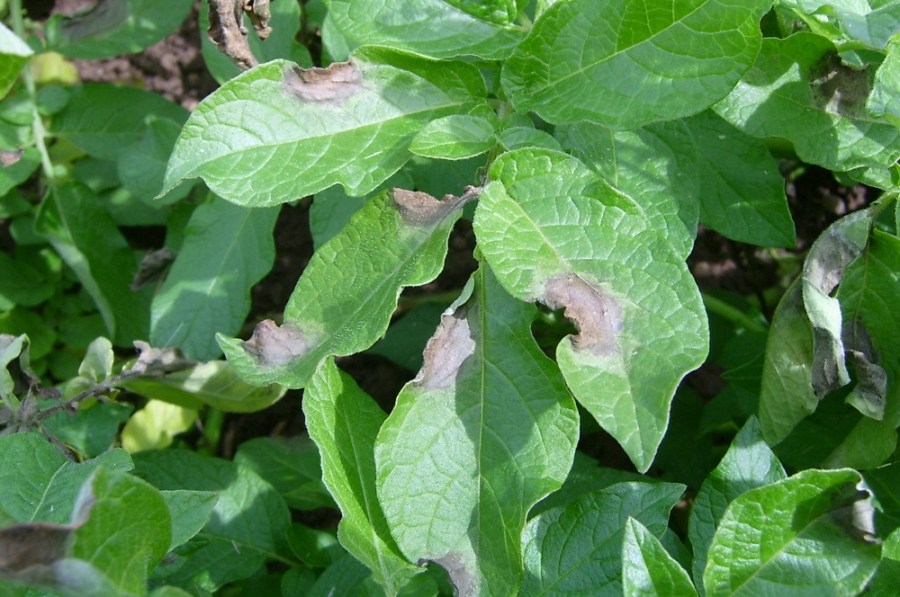It’s recently been confirmed that new blight strain 37_A2 is fluazinam-resistant. CPM looks at the implications on tuber blight control strategies.
37_A2 has shown no insensitivity to other actives.
By Lucy de la Pasture
Last year, a new blight strain was detected in the UK – 37_A2 (Dark Green). It was found in five outbreaks (both tuber and foliar blight) in Leics, Staffs and Yorks. At the time of reporting the results for genotyping in the 2016 season, a watching brief on 37_A2 was observed, but now results from Wageningen University & Research show that all of the 37_A2 isolates tested displayed a reduced sensitivity to fluazinam.
Blight experts believe there’s a strong indication that the rise of the strain in Europe isn’t only caused by its better fitness, but also by a selection advantage in situations in which fluazinam is used.
EuroBlight annually monitors and reports on the development of phytophthora genotypes in Europe. The results of 2016, which in many countries was a serious late blight year, showed that two relatively new genotypes are on the rise, 36_A2 and 37_A2.
Their survival and spread, at a time when other clones have failed to establish themselves in a population where 6_A1 and 13_A2 have predominated for a decade, suggests they are evolutionarily fit and may pose challenges to disease control.
According to potato specialist Eric Anderson of Scottish Agronomy, most successful blight clones appear to be triploid.

Eric Anderson says avoid back-to-back applications of fluazinam, either alone or in mixtures.
“The hypothesis is that it gives them genetic flexibility due to an additional copy of genes, which means that any negative mutation is buffered,” he explains.
“Triploid clones may also be fitter due to their theoretically larger cell size. There have been continued observations of new clone 36_A2 in Netherlands, Belgium and Denmark since 2014, but to date it hasn’t been found in the UK.”
When 37_A2 was first detected in a single sample from the Netherlands in 2013, it was sampled locally at a low frequency in the following two seasons. But in 2016 the new dark green strain made up 5.5% of the EU-population sampled, having spread as widely as England, Germany, Belgium, the Netherlands and NW France.
So why was this? Originally it was assumed that 37-A2 could establish due to its fitness. Current results indicate that other characteristics also contribute to the increase of this genotype and one of those is reduced sensitivity to fluazinam, explains Eric Anderson.
The million-dollar question is should UK growers be worried? Syngenta’s Douglas Dyer believes they should be mindful of developing blight strains less sensitive to fluazinam, but by selective use and active planning, they can effectively preserve the full benefit of fluazinam (Shirlan) for tuber blight protection at the season end.
He highlights the zoospore control obtained with fluazinam makes it an important component of the programme, particularly at the end of the season.
“With the reported increasing incidence of 37_A2, it’s important growers and agronomists adapt blight programmes now to minimise the risk of further spread.”
Current advice is to reduce the selection pressure exerted by fluazinam by limiting the number of applications with fluazinam-containing products, and alternate with other active ingredients. Additionally, the use of products where fluazinam is combined with other active ingredients also lowers the selection pressure.
Douglas Dyer advocates this approach of using alternative blight actives for foliar blight applications through to desiccation, alternate actives in the programme, or mixing another active with the fluazinam treatments – such as cymoxonil or mancozeb, or better still both – particularly under high pressure situations.
“37_A2 has shown no insensitivity to other actives, so programmes including other actives will maintain full efficacy and limit the potential for the strain to develop. Fully protecting the foliage from blight is still the best way to minimise risk of infection spreading to tubers.”

Anti-resistance strategies need to be adopted to ensure fluazinam remains effective on tuber blight.
Eric Anderson emphasizes that it’s essential to avoid creating selection pressure through using repeat applications of fluazinam. The active is still likely to feature as part of tuber blight control strategies, particularly for Albert Bartlett growers who are precluded from using Infinito,” he advises.
He’s also wary of applying fluazinam with cymoxanil because he doesn’t believe the fluazinam will be protected adequately.
“Cymoxanil will run out of steam within 3-4 days, which leaves fluazinam on its own for at least days 5-7 on a seven-day programme,” he argues.
“In light of the current position, and until we have more information from genotyping in the 2017 season, avoid applying fluazinam back-to-back, even when using in mixtures. If you’re retaining seed on the farm and use fluazinam in the final blight spray, then it would be sensible to avoid using fluazinam or fluazinam plus cymoxanil at the start of the 2018 blight programme, without the addition of another foliar blight product,” he adds.
Eric Anderson feels strongly that growers of processing crops shouldn’t rely on fluazinam for their tuber blight control.
“If blighted tubers go into a processing store, they will breakdown quickly at the higher temperature, which can’t be brought down to slow the development of blight. Potentially this is disastrous so I’m advising growers of processing varieties to adopt an alternative approach, which doesn’t include fluazinam,” he says.
Where 37_A2 has been kept out of crops through the growing season, there’s less risk if using fluazinam to protect against tuber blight at desiccation, believes Douglas Dyer.
He comments that where full blight programmes have been used, the Green 33 blight strain, which has also shown reduced sensitivity to fluazinam, appears to have been effectively managed, with the population maintained at negligible levels in the UK.
“Implementing resistance management recommendations now could avoid problems with disappointing efficacy, whilst also preventing the further rise in prevalence of this new strain.”




